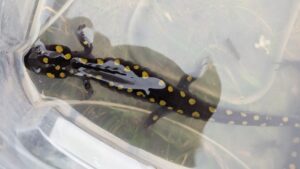Salamanders are small, quiet animals that live in wet, cool places like under rocks or logs after it rains. They look gentle and harmless. But can salamanders get cancer?
Yes, salamanders can get cancer, just like other animals. But it doesn’t happen very often, and researchers are still trying to understand why. In fact, some salamanders might even have a natural resistance to certain kinds of cancer, and that has scientists very interested.
What Is Cancer?
Cancer starts when cells in the body grow too fast. Normally, cells grow, divide, and die in the right order. But sometimes things go wrong.
A cell might begin growing uncontrollably. It ignores the body’s signals to stop. This uncontrolled growth leads to tumors.
Cancer happens in humans, dogs, cats, and many other animals. It can also happen in salamanders. But salamanders seem to get cancer much less often than other animals.
How Common Is Cancer in Salamanders?
Cancer is not common in salamanders at all. Wild salamanders are almost never found with tumors.
Some salamanders in labs or zoos might develop growths, but even then it does not happen often.
Over the years, a few reports have documented tumors in different types of salamanders. These cases are rare.
Scientists do not know exactly how often cancer occurs in wild salamanders because sick animals often hide.
This low cancer rate is surprising. Salamanders live in forests and near water. Some live in polluted areas where other animals get cancer more often. But salamanders seem to handle these environmental risks better.
Why Don’t Salamanders Get Cancer More Often?
This is where it gets interesting. Salamanders have an amazing ability to grow back lost body parts. If a salamander loses a leg or a tail, it can grow it back. They can even regrow parts of their organs.

This is more than a neat trick. It shows salamanders have very good control over their cells.
To regrow a body part, cells must divide and multiply quickly. This fast growth usually risks cancer.
But salamanders keep these new cells under control. It is like they have a built-in safety system. This system lets them regrow parts without cells turning bad.
Some scientists think this regenerative ability helps prevent cancer. Salamanders might catch cell problems early or fix damaged DNA before cancer starts.
What Happens When Salamanders Do Get Cancer?
Although rare, some salamanders do get cancer. Tumors have been found on their skin or inside their bodies, including the liver or bones.

Most cases were in salamanders kept in research labs.
It is hard to know if wild salamanders face the same risks because sick animals hide. If a wild salamander had cancer, it might not live long enough for anyone to see.
Scientists noticed the cancer sometimes acts differently than in other animals. It can grow slowly and may not spread easily.
This suggests salamanders might have natural ways to control cancer. Their bodies might slow or stop cancer cells from spreading.
Could Salamander Research Help Humans?
Scientists are very interested in how salamanders control cell growth. Understanding this could help humans.
Researchers study the special genes salamanders use to regrow body parts.
These genes tell cells when to grow and when to stop. Using these signals in humans might help treat injuries or stop cancer from spreading.
This research is still early. It takes time to understand. But the idea that salamanders hold secrets to cancer prevention gives hope to scientists worldwide.
Some researchers study salamander proteins made during regrowth. Others look at their immune systems.
Each discovery helps bring us closer to new regenerative medicines.
Should Pet Owners Worry About Cancer?
If you have a pet salamander, cancer is probably not your biggest worry. Keeping the right temperature, humidity, and diet matters more.

Most salamanders will never develop tumors, especially in clean, healthy environments.
Still, if you see a strange lump or bump on your salamander, watch it.
If your pet stops moving normally or stops eating, contact a veterinarian. Cancer is rare but possible.
Sometimes lumps are cysts, injuries, or infections. A vet who works with exotic animals can help find out what is wrong.
What This Means for Science
Salamanders show us that not all animals get cancer the same way. Their ability to regenerate might help them avoid tumors.
Their natural defenses give scientists insight into controlling cell growth. This knowledge could help us understand and prevent diseases.
The study of salamanders is part of regenerative medicine.
This field explores how living things heal and regrow. Scientists hope to use this to help people heal injuries and illnesses.
Other Animals That Rarely Get Cancer
Salamanders aren’t alone. Sharks, elephants, and naked mole rats also get cancer less often than expected.
Each uses different ways to protect themselves.
Sharks have special immune systems. Elephants have extra copies of cancer-fighting genes. Naked mole rats’ cells stop growing when crowded.
Studying all these animals helps scientists learn ways to prevent cancer.
Conclusion
So, can salamanders get cancer? Yes, they can. But it is much less common than in other animals.
Their bodies seem to have special ways to control cell growth and prevent tumors.
That does not mean salamanders are perfect. They can still get sick from other things.
But their natural defenses against cancer are impressive. They give clues about preventing or treating cancer in humans.
Whether caring for a pet salamander or watching them in nature, it is amazing what these quiet animals teach us.
Hi, my name is Ezra Mushala, i have been interested animals all my life. I am the main author and editor here at snakeinformer.com.

